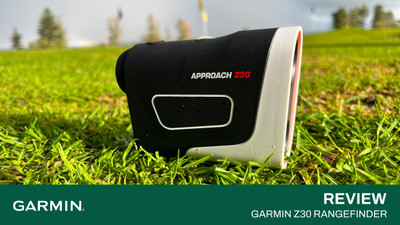Garmin Approach Z30 Rangefinder — Review
Posted by Jamie Martin on 28th Jun 2024
If you are a golfer with preloaded prejudices in the rangefinder vs GPS debate, it might be best to look away now.
The new Garmin Approach Z30 rangefinder isn’t your average rangefinder. It does all the things most other rangefinders do. It boasts a 366m range and instant yardage calculations that are accurate to within 91cm. It also offers x6 magnification and an OLED viewfinder. And it buzzes to signify the pin has been located and locked on to.
But it also does something completely new; something no other Garmin rangefinder has ever done before.
It can share.
The Approach Z30 integrates with other Garmin devices, such as a GPS watch or a mobile device running the Garmin Golf app, to deliver the most accurate answer to that age-old question: where’s the pin, and how far from the edge of the green is it?
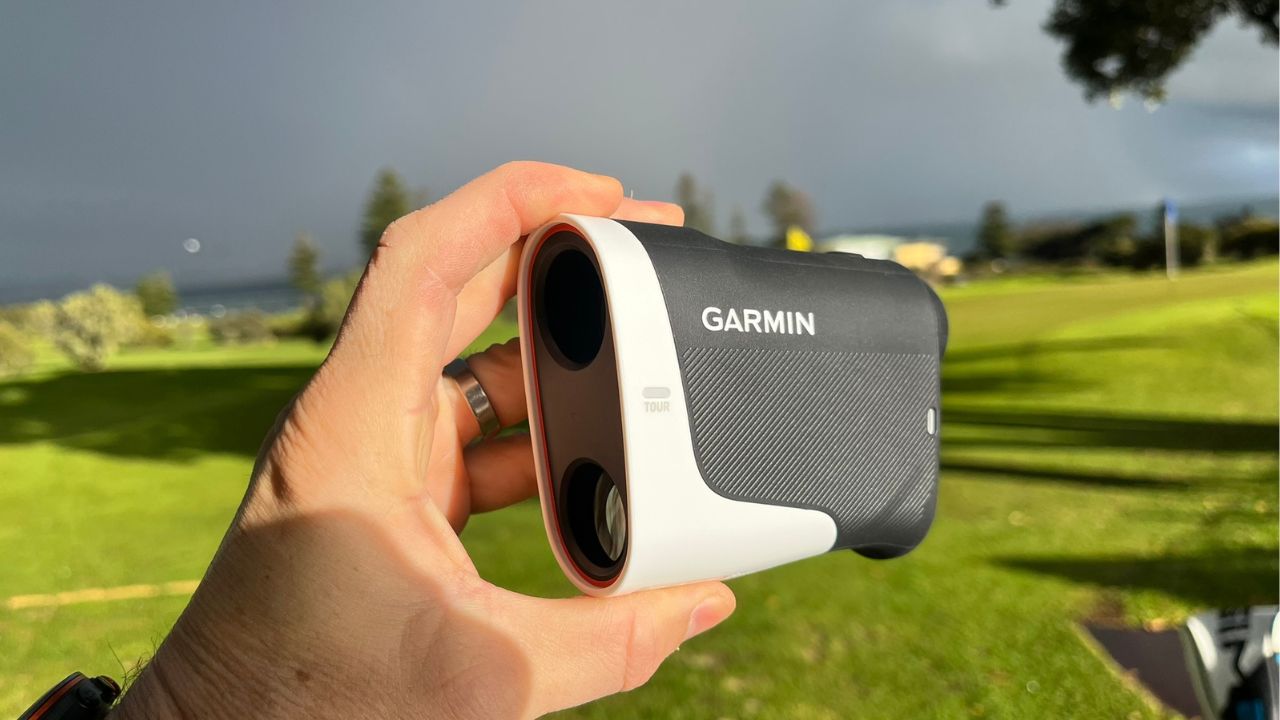
FIRST IMPRESSIONS
Garmin products always feel well engineered and properly put together, and the new Approach Z30 displays similar good graces.
It has a taut and stylish look that mimics Garmin’s Approach Z82 rangefinder. A Star Wars geek told me there is a definite resemblance to a scout trooper’s helmet, and that the Z30’s robust design and monochromatic tones wouldn’t look out of place on Endor. I simply nodded and turned quickly on my heels before this man-child could deliver his perspective on Imperial-designed speeder bikes, and similar sorts of nonsense.
The Z30 is slightly smaller than the Z82 and weighs only 210g, which I certainly didn’t dislike, and it comes with a neat, zipped protective cover that clips to a bag.
After taking the rangefinder out of the box, the first order of business was inserting the battery into one of those jar-top lids just under the viewfinder. Apparently, you’ll only need to change the battery once a year, which seems better than having to plug the unit in for a recharge every few rounds.
Inside the Z30’s viewfinder, you’ll see the requisite red OLED targeting crosshair, along with a few other things too dull to speak about. The unit has two buttons on top: a range button that switches the Z30 on and fires the laser, and a mode button that toggles between metres/yards and can cancel the unit’s slope function for tournament use.
At this point you could hit the course immediately and begin lasering pins in non-synced mode. But that would be akin to buying a brand-new Tesla, hitching it up behind a horse, and towing it home. Or purchasing the latest iPhone and using it only to call people, a concept now deemed anachronistic and downright peculiar by my teenage offspring anyhow.
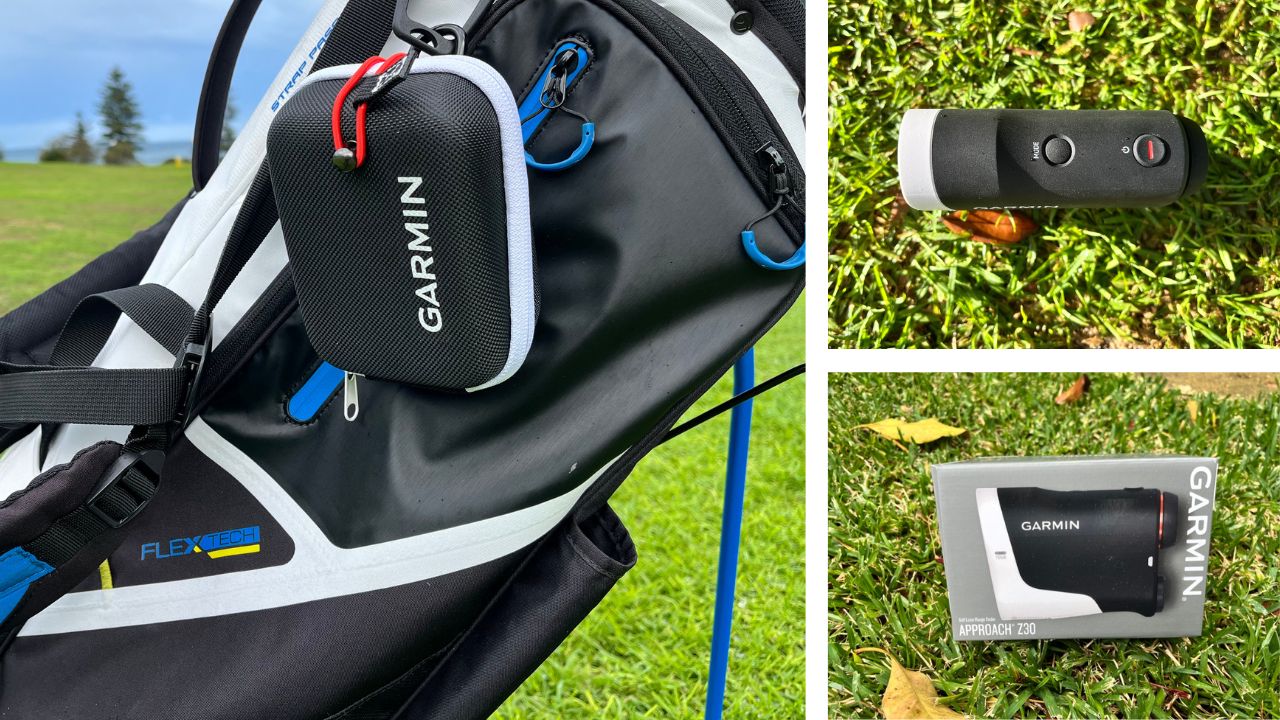
PAIRING THE GARMIN APPROACH Z30
Connecting the Approach Z30 rangefinder into the Garmin ecosystem is a necessity to extract the most out of the device. I’ll explain why later. But first I shall describe my “sync or swim” test, an admittedly witty play on words that has actually become an essential part of a golf tech review.
The good news was the Z30 syncing process didn’t take as long as I was expecting, although I must admit I was distracted somewhat watching a bloke on the putting green with a stroke twitchier than a problem gambler in Las Vegas.
I suspect the surprising swiftness was because I already had the Garmin Golf app on my iPhone and had set up a user account. The app was also already synced with the Approach S70 GPS watch on my wrist. If you were starting from scratch, the pairing process could conceivably take much longer.
In the Garmin app, I headed to the Garmin devices tab and selected the Approach Z30 option. Then I woke the Z30 up, waited for the app to find the rangefinder then pressed start to pair the device. It took under a couple of minutes to complete successfully.
Pairing the Z30 to my Approach S70 GPS watch was much the same, although I had to add it as a new device within the Sensors and Accessories menu on the watch.
With the two devices paired, the flow of information could begin.
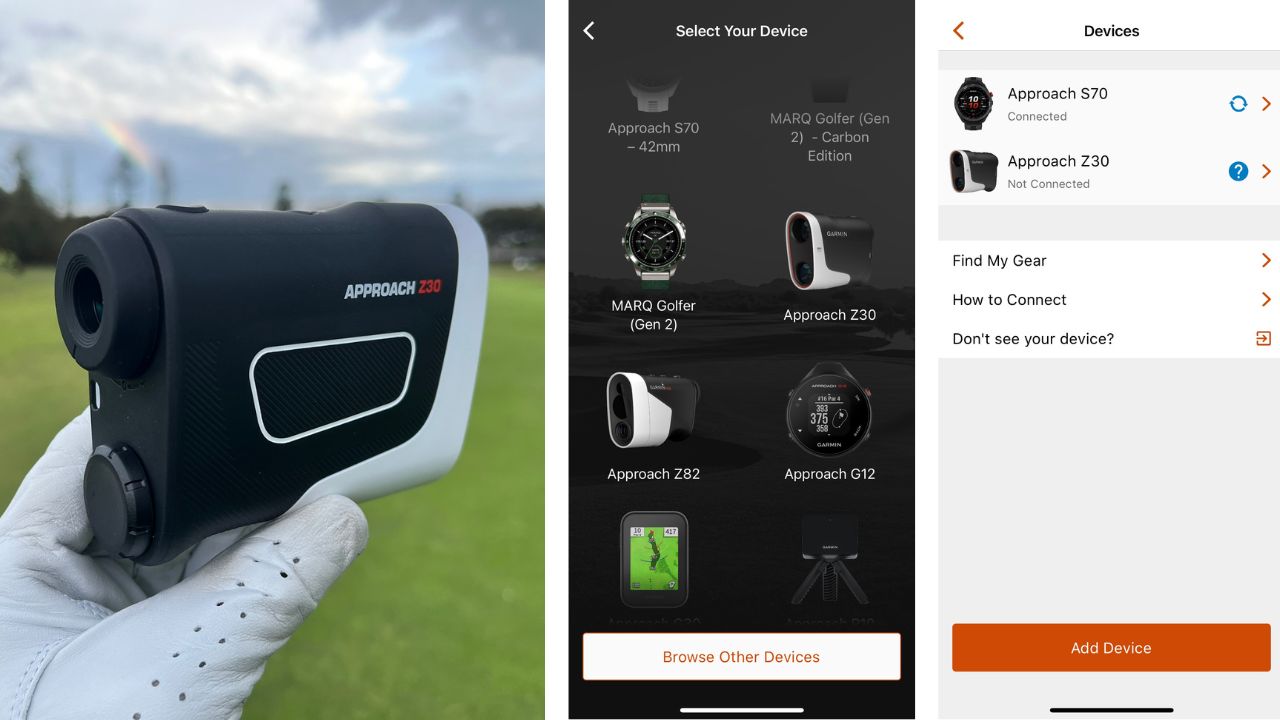
HOW IT PERFORMED
With the Approach Z30’s communication capabilities, Garmin have midwifed a pretty cool new distance function. It’s called Range Relay and it works like this.
A player lasers a pin using the Z30 rangefinder. The Z30 relays the pin information to the Approach S70 GPS watch, which then updates the pin position on the watch’s green map. The watch uses the pin distance to generate a yardage to the green’s front and back edge and sends all the info back to the Z30’s viewfinder.
You only need to laser the pin once per hole, even off the tee (if it’s within the Z30’s 366m range) because the Range Relay feature updates yardages as the user progresses along the hole. Range Relay distances are shared in the Z30’s viewfinder, on the screen of a connected GPS watch or within the Garmin Golf app, which is the central hub in the distribution process. Essentially, you’re receiving the best of both worlds with the Approach Z30: accurate GPS distances and a precise flag location — shared across all your Garmin devices.
As a standalone rangefinder, the Garmin Approach Z30 does offer a PlaysLike distance in the viewfinder, which compensates for the standard downhill or uphill slope. But when synced with an Approach S70 GPS watch, the PlaysLike calculation factors in environmental conditions such as wind, temperature, air pressure and humidity, leading to the most accurate PlaysLike yardage in the game.
The Z30 also features a magnetic mount that can secure the rangefinder to the metal frame of a golf cart or buggy. And it’s also compatible with the Find My Garmin app, which is an extremely useful tool to retrieve the Z30 if it’s misplaced or lost somewhere on the golf course.
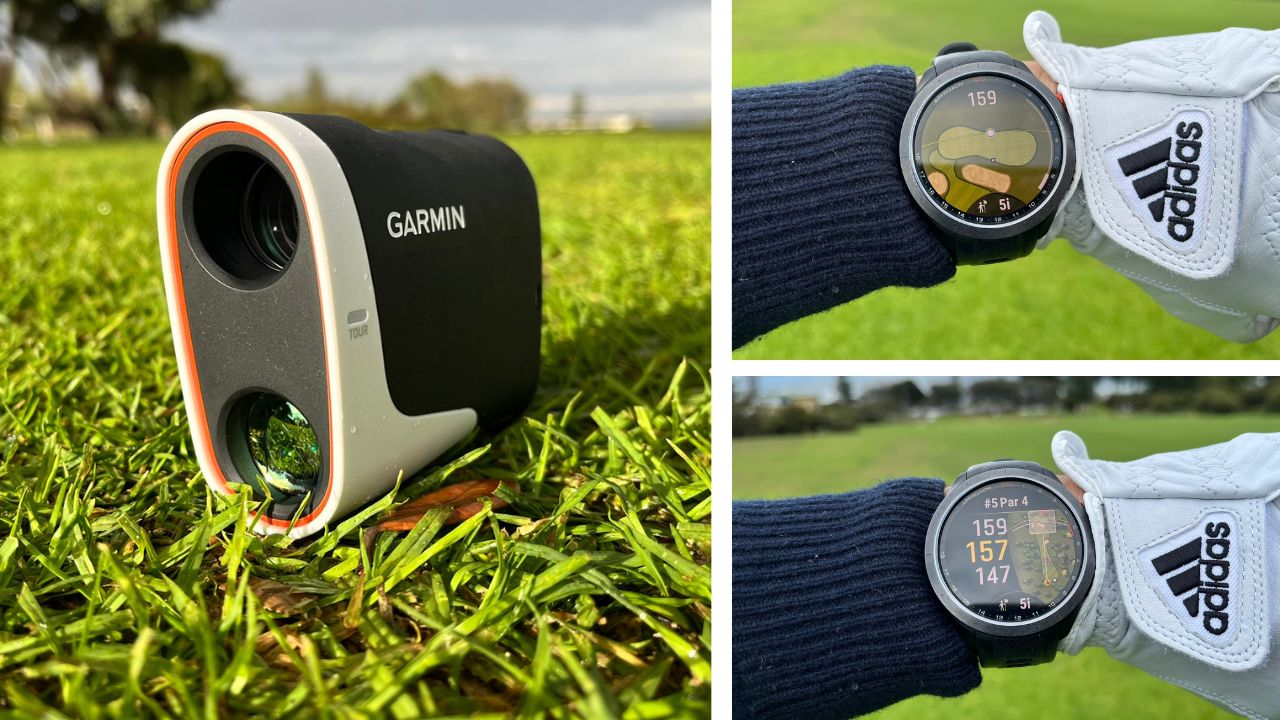
THE FINAL WORD
The introduction of the Garmin Approach Z30 is shaping as the inflection point in the distance-measuring device debate. The Z30 isn’t a replacement for Garmin’s Approach Z82, which combines laser range finding capabilities with overlaid GPS yardages and course and green mapping in the viewfinder.
Rather, it’s a slightly simpler and smaller unit that pulls together the advantages of a rangefinder (precise pin distance) and the benefits of a GPS device (front, back and middle distances to the green and the capacity to point out where the hazards are). But is it the missing link that settles the Rangefinder v GPS debate forever?
For golfers who already own both a rangefinder and GPS device, the Z30’s integrated Range Relay function will seem like a no-brainer. It works as advertised and existing Garmin users will probably be the first to jump on board. However, the Z30 will lock users into the Garmin ecosystem, similar to the gravitational pull of the Apple or Android ecosystem when choosing a handset.
I was disappointed to see the Approach Z30 didn’t include Garmin’s PinPointer function. But it’s possible I was expecting too much from the Z30 given it’s Garmin’s mid-level rangefinder. Indeed, perhaps the most shocking thing about the Z30 is its price. It’s probably a hundred bucks under what they could’ve charged for a product that essentially upgrades the performance of every device it connects with.
Garmin have ensured nearly every GPS watch they’ve made will sync with the Z30. Approach watches S70, S62, S42, S12 are all compatible, along with Garmin’s non-golf specific watches like the Fenix, Epix, Enduro and Marq (Gen2). Even the Garmin Approach G12 handheld GPS is compatible.
I am absolutely confident Garmin fans are going to enjoy the Approach Z30. Non-Garminites should also be drawn to the rangefinder given it offers the best of both worlds, along with any fence sitters who can't make up their mind between a rangefinder and GPS device. Given Garmin’s lengthy time span between new releases, the Approach Z30 should be a winner for several years to come.
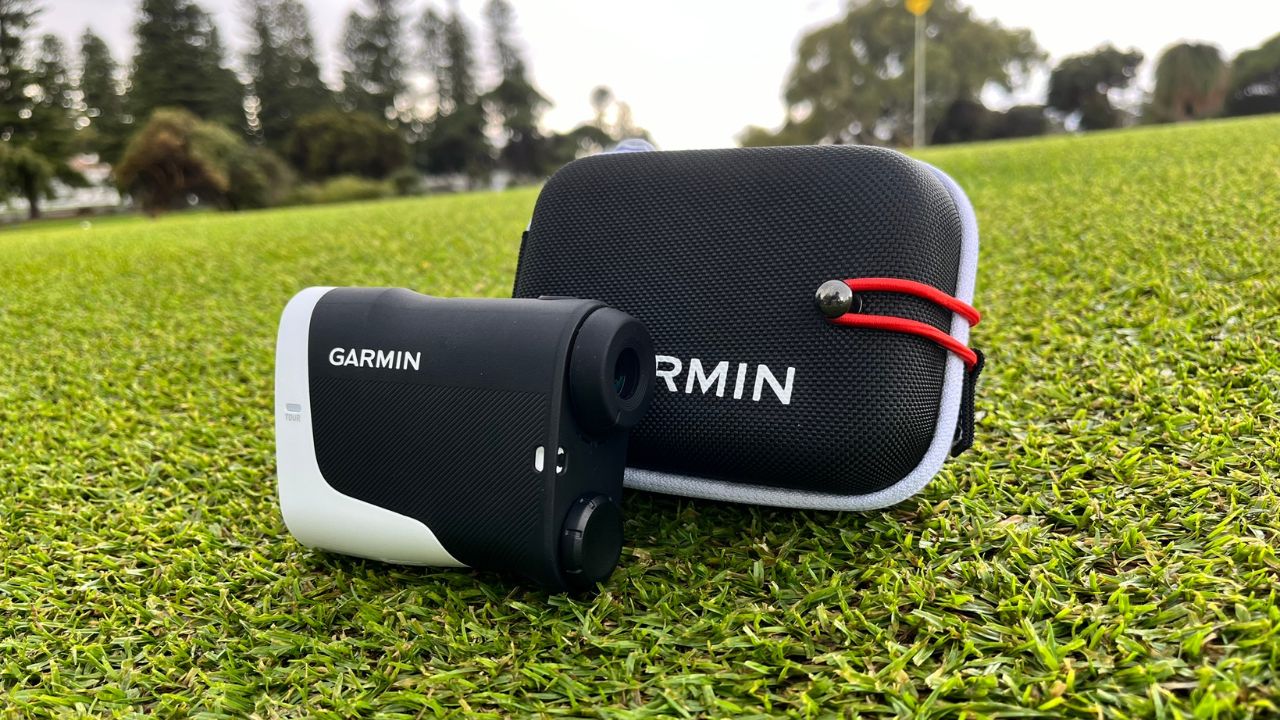
THE VERDICT
HIGH FIVES
• Combines advantages of a rangefinder and GPS device
• Was easy to pair with Garmin app
• Works well as a standalone rangefinder
• Range Relay function is a first
• Good value and excellent features for a mid-range device
BUMMERS
• No PinPointer function
• Locks a user into the Garmin ecosystem

|
Written by Jamie Martin
Jamie Martin is currently locked in a battle to keep his handicap hovering around the mid-single digits. Despite his obvious short-game shortcomings, Jamie enjoys playing and writing about every aspect of golf and is often seen making practice swings in a mirror.
|

